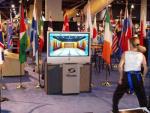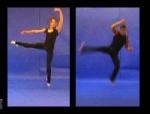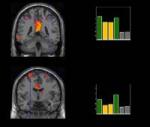Feb 28, 2005
Virtual-Reality Movies Put a New Face on "User-Friendly"
FROM THE PRESENCE-L LISTSERV: (From UB News, the news service of the University of Buffalo)
Virtual-Reality Movies Put a New Face on "User-Friendly"
Intense psychological drama requires computer agents to be "more human"
Release date: Thursday, February 24, 2005
These improvisational computer agents are expected to influence the development of electronic devices of tomorrow, making them much more user-friendly because they will be able to respond to the idiosyncratic needs of each user.
The researchers' virtual-reality drama, The Trial The Trail, is a brand new type of dramatic entertainment, where instead of identifying with the protagonist, the audience becomes the protagonist.
The multidisciplinary team formed two years ago when Josephine Anstey, assistant professor in the Department of Media Study in the UB College of Arts and Sciences, was looking for ways to make VR dramas more believable. At the same time, Stuart C. Shapiro, Ph.D., professor in the Department of Computer Science and Engineering in the UB School of Engineering and Applied Sciences, was seeking applications to challenge the computerized cognitive agent called CASSIE that he and his colleagues had developed.
"We started thinking, 'What happens if you put a powerful artificial intelligence system -- which is what Stu has developed -- together with drama and stories?'" recalls Anstey. "The potential seems endless. You can get to the point where you have virtual characters that can believably respond to humans in real-time."
Instead of sitting in a darkened theater and passively watching a story unfold, human audience members in this interactive drama stand up, don gloves and headgear and become immersed virtually in the world of the characters on the screen.
Instead of using a joystick to compete against virtual characters as in a video game, the actions and utterances of human users determine how the virtual characters respond, based on an ever- growing "library" of actions and verbal communications with which the VR characters are endowed.
"Because of these attributes, we are creating a more intense psychological drama for users," said Anstey. "We are creating characters that are more similar to those you'd find in a novel."
The UB team fully explored these concepts in a paper presented last year entitled "Psycho-Drama in VR."
By necessity, added Shapiro, those characters are computational agents that must be capable of behaving in sophisticated and very human-like ways, attributes that also can help take "user- friendliness" for computers and other electronic devices to new heights.
"This is a step in the design and implementation of computer agents that are aware of themselves and their actions, as well as the environment they are in," he explained, "so this work is relevant to any application in which people interact with a device or system."
Shapiro referred to the team's approach toward its virtual characters as "cognitively realistic."
"We use a kind of computational 'self-perception' so that just the way that hearing people can pace their speech more effectively than deaf people, here's an agent that 'hears' computationally and can respond to what's happening," he explained. "The agent has some perception of itself and some level of self-awareness."
While other computer scientists are exploring multiple agent systems, he continued, this project is more demanding because the agents in the drama must be able to "perceive" themselves and then respond to the user.
So, as the human user proceeds through the drama, his or her actions are being recorded computationally over the Internet, interpreted psychologically and used to prompt the responses by the virtual characters.
In a sense, the computational agents in the drama must improvise around the human user, who is acting spontaneously without a script.
This, Anstey says, is a grand departure from the way that humans experience other types of computational dramas, such as video games.
"Very few computer games' characters have psychological lives that you can respond to," she says.
Because of this, the drama is different every time, a factor that the researchers say is both a more challenging and exciting type of entertainment, while also more computationally demanding.
In the UB drama, the main VR character is a dramatic representation of CASSIE, the cognitive agent, based on SNePS, Semantic Network Processing System, a knowledge- representation system developed over the past several decades by Shapiro and William Rapaport, Ph.D., UB associate professor of computer science, and scores of UB graduate students.
SNePS endows a computational agent with the ability to perform reasoning tasks, make inferences and do belief revision, where it can correct itself if it obtains additional information that indicates that it was misled initially.
"Cassie is one of the few intelligent agents that can process and communicate in natural language," said Shapiro. "You can talk to her in English."
He explained that one SNePS runs for each agent in the drama, and they are learning to communicate and interfere with one another.
"For computer-based fiction to really emerge, there has to be a lot of work using intelligent agents," said Anstey. "Anybody interested in the fiction and drama of the future can't ignore this.
Writers will have to build these skills, will have to, in a way, think more like computer scientists."
In addition to Anstey and Shapiro, the UB team consists of David Pape, assistant professor in the Department of Media Study in the UB College of Arts and Sciences; Anthony Ekeh, a graduate student in computational linguistics; Michael Kandefer, a doctoral candidate, and Trupti Devdas Nayak, a graduate student, both in the Department of Computer Science and Engineering, and Orkan Telhan, a graduate student in media study.
Contact: Ellen Goldbaum, goldbaum@buffalo.edu
Phone: 716-645-5000 ext 1415
Fax: 716-645-3765
16:35 Posted in Cybertherapy | Permalink | Comments (0) | Tags: virtual reality therapy
Feb 11, 2005
Congress on Virtual Reality Appications - CARVI 2005
9th and 10th of June * Vitoria-Gasteiz (Spain)
EUVE Technological Center specialised in Virtual Reality, Virtual Engineering and Hidrometeorology is pleased to announce you the 3rd edition of the International Congress in Virtual Reality Applications where the last advances in Research and Development in applied Virtual Reality will be show. Besides CARVI 2005 will be a meeting point among researchers, companies and users.
The topics of CARVI2005 will be about the Virtual Reality Applications on:
- Product design and manufacturing processes.
- Architecture, Culture and Archaeology.
- Virtual Reality in Scientific Applications.
- Television, films and advertising.
- Simulation, coaching and trainning.
- New tools, new technologies.
The deadlines for the publication of projects or research lines are:
Abstract due date: March the 8th 2005
Accetance notice: March the 16th 2005
Full paper due date: April the 26th 2005
All the information related to the Congress can be found at CARVI web site
15:36 Posted in Positive Technology events | Permalink | Comments (0)
Cibex-Trazer VR system for neurorehabilitation
Retrieved from: the PRESENCE - Listserve
It may sound like science fiction, but it’s exactly what Bob Verdun, the new director of the Pawtucket Family YMCA, wants to achieve with a cutting-edge piece of fitness equipment called the Trazer.
The Trazer is a serious machine, using optical sensors, an electronic "beacon," and interactive, virtual reality software to facilitate exercise training, sports testing and rehabilitation -- but Verdun is more interested in its kid-appeal.

That’s because the Trazer is the fitness equivalent of the nutritious Twinkie: A virtual reality video game designed to make excise universally accessible and, believe it or not, fun.
"There is a resistance for kids who are not good at team sports to join a school team, and these are usually the kids who need exercise the most," said Ray Giannelli, the senior vice president of research and development for Cybex International, the Massachusetts-based company that will ship three of the first production Trazers to Pawtucket this spring.
The Trazer, said Giannelli, will give sports-adverse kids a fighting chance to stay in shape by putting simple, effective exercises within the familiar context of a video game.
"A lot of kids today are on the computer all day, e-mailing or chatting or playing video games," said Verdun, "This is the perfect bridge to exercise, a viable way to win the war against childhood obesity."
Here’s how it works:
Optical sensors mounted beneath a sleek, high-definition video display are trained to register the movements of an electronic beacon in a 6-foot, three-dimensional space.
When the beacon is attached to a belt worn by the user, his or her movements are mimicked in real-time by a virtual character in a virtual world.
An easy-to-navigate options menu features interactive programs for performance testing and sports training, as well as rehabilitative movement therapy, kinesthetic learning and fitness fun.
There are programs designed for the elderly to help them strengthen neglected muscles and maintain a full range of motion, and games designed to keep kids excited about physical activity.
In one game called "Trap Attack," players are required to move their virtual self across a three-dimensional chessboard, in sync with a roving red cursor.
Play the game on a basic difficulty setting, and the cursor moves relatively slowly, one square at a time. Crank up the difficulty, and trapdoors will appear, forcing you to jump over them.
Another game, "Goalie Wars," allows the player to intercept and "catch" soccer balls thrown by a virtual goalie. Once caught, a ball can be thrown back by lunging forward, and if you fake-out your polygonal opponent, you score a point.
Although optical sensors and virtual reality video games are impressive, they’re not exactly new.
The real meat and potatoes of Trazer is its ability to analyze and tabulate the data it collects. While you play "Goalie Wars" or "Trap Attack," the Trazer is measuring your reaction time, acceleration, speed, power, balance, agility, jumping height, endurance, heart rate and caloric output.
These statistics are displayed and saved after the completion of each exercise, a feature which will allows serious athletes, convalescents and kids to quantify their performance and track their progress.
As they’re fond of saying at Cybex, Trazer has more in common with a flight simulator than an exercise machine.
The Trazer is a versatile exercise machine, but Verdun and his colleagues are hoping it will be a crowd-pleaser as well.
Although the Trazer is still in development, a video demonstration of its capabilities and a hands-on demonstration of the more conventional Cybex Arc Trainer -- a high-tech step- machine -- are expected to be the main attractions at the YMCA’s open house on Saturday.
Scheduled for Saturday, from 10 a.m. to 12 p.m., the open house is a sneak preview: a way to show current and prospective members what they can expect from the Y’s $8 million facelift -- a soup-to-nuts overhaul which will include renovated facilities, expanded program space and brand-new, state-of-the-art fitness equipment.
The ultimate goal is to make the YMCA more family-friendly and appeal to old people, young people and everyone in between. To Verdun’s thinking, what better way to bring the 115-year-old building into the realm of iPods and Instant Messages than a video game.
"We want parents and children to know that there isn’t anything they can’t do at our facility," Verdun said in a recent interview.
"Families can come here, exercise together, and share an experience that is affordable, safe and fun.
"You don’t think about moving around when you’re on the Trazer, and that’s exactly what we want. The essence of the YMCA is having fun."
15:30 Posted in Cybertherapy | Permalink | Comments (0) | Tags: Positive Technology, virtual reality
Feb 10, 2005
Cyberart Festival
The Boston Cyberarts Festival is an international biennial festival of art and technology in all media. The next Festival will take place April 22 through May 8, 2005. It will include visual and performing arts and explore how artists throughout the world are using computers to advance traditional artistic disciplines and create new interactive worlds.

The 2005 Festival will also feature two conferences during the opening weekend: eMerging Arts and Technologies, for artists and high-tech company professionals; and Ideas in Motion, focused on innovations in dance, movement, and technology.
13:46 Posted in Cyberart | Permalink | Comments (0)
Speaking with objects
The art and soul of a new machine
by Missy Sullivan, Forbes Magazine, 09.20.99
Did you ever notice how a chicken wishbone, turned upside down, looks remarkably like a bowlegged cowboy in chaps? Ever imagine a cloud gliding down from the sky bearing gifts? C'mon, admit it. In some idiotic moment of utter boredom you have fantasized about blowing something up.
For most people, these are idle thoughts. But reveries like these are what inspired sculptor, inventor and award-winning toy designer Arthur Ganson, 44, to create his wondrous machines.
He had that wishbone epiphany. It's embodied in a clattering contraption of wires, gears and pulleys that makes a chicken wishbone swagger like a miniature John Wayne. The cloud fantasy? On their first anniversary his wife looked up to see a tray of chocolate and sake descending on a mechanical cloud that he was diligently lowering from the ceiling.

You can see the outcome of Ganson's big-kaboom dream for yourself on your next trip to Boston. Just head over to his exhibition at the Massachusetts Institute of Technology Museum--he's an artist-in-residence at the school--where a wildly popular machine repeatedly blows up and reconfigures a miniature yellow chair.
These are just a few of the fantastical creations from Ganson's studio outside of Boston. Frank Maresca, co-owner of the Ricco/Maresca Gallery in New York (where a Ganson sculpture goes for between $15,000 and $60,000), describes the studio as a cross between Santa's workshop and mission control for the moon launch.

This helps explain why Ganson has something of a cult following among local college students, some of whom return to the MIT exhibit 40 to 50 times. A comment in the visitors book from an even younger fan: "You're either a psycho or a genius, or both. Either way, you rule!"
But Ganson's machines are a lot more than just clever gadgets. The art part comes in the way his mechanical gestures so intuitively and eloquently convey human feelings. Wriggling inchworms, mincing feather dusters, Kabuki-dancing miniature plastic swords. Ganson's work celebrates life with a sense of wonderment and humor that's all too rare in the self-important world of contemporary art.
You can see it in the reactions to Ganson's work up at MIT. Eyes widen in front of torn-paper "wings" fluttering poignantly atop a forest of thin wire poles. And people actually blush before the machine that erotically spurts grease on itself.
One recent work, "Machine with Artichoke Petal," stands a dried-up little leaf atop a wheel, its curled tip perfectly evoking a dejected head. Set the wheel in motion and the schlumpy little guy starts trudging slowly along like Willy Loman after a bad sales day.
"It's astounding to me that someone can make a machine with such nuanced and complex emotional resonances," says Nicholas Capasso, curator of Ganson's first one-person museum show in 1993 at the DeCordova Museum & Sculpture Park in Lincoln, Mass. "Anyone can make a machine that waves, but only Arthur can make a machine that waves good-bye. There's a big difference."
About the artist
Arthur Ganson has been making kinetic sculpture for 27 years, having received a BFA from the University of New Hampshire in 1978. He has exhibited his machines in galleries and museums in the United States and Europe. A former artist-in-residence at the Massachusetts Institute of Technology, he maintains an ongoing exhibition of sculpture at the MIT Museum in Cambridge. Recently he appeared as a cartoon bear on the animated children's series "Arthur," and his friends say the likeness is remarkable. Ganson is the inventor of the award-winning children's toy Toobers and Zots. He lives and works near Boston. More work may be seen at his Web site, www.arthurganson.com.
13:38 Posted in Cyberart | Permalink | Comments (0)
Brain-imaging study on action observation and acquired motor skills
Earlier studies with monkeys revealed that brain cells called “mirror neurons” respond both when we do something, like pick up an object, and when we simply watch someone else do it. It was known that these neurons fire when we perform an action, but it was unexpected that the same cells also fired when we only saw that action being performed. This new study by Calvo-Merino and coll., recently published on the journal “Cerebral Cortex”, goes a step further by showing that such a system operates differently depending on what a person is physically expert at doing.

According to the authors of the experiment, this is the first proof that our personal motor repertoire - the things that we have learned to do - changes the way that our brain responds when we see the movement. In particular, these findings suggest that once the brain has learned a skill, it may simulate the skill without even moving, through simple observation: an injured dancer might be able to maintain his skill despite being temporarily unable to move, simply by watching others dance.

These results provide further support to the I-Learning Project clinical rationale, and justify the use of I-Learning technology to better rehabilitate people whose motor skills were damaged by stroke.
Reference: B. Calvo-Merino, D.E. Glaser, J. Grezes, R.E. Passingham and P. Haggard, Action Observation and Acquired Motor Skills: An fMRI Study with Expert Dancers, Cerebral Cortex, Dec. 2004
13:20 Posted in Mental practice & mental simulation | Permalink | Comments (0) | Tags: mental practice, motor imagery






